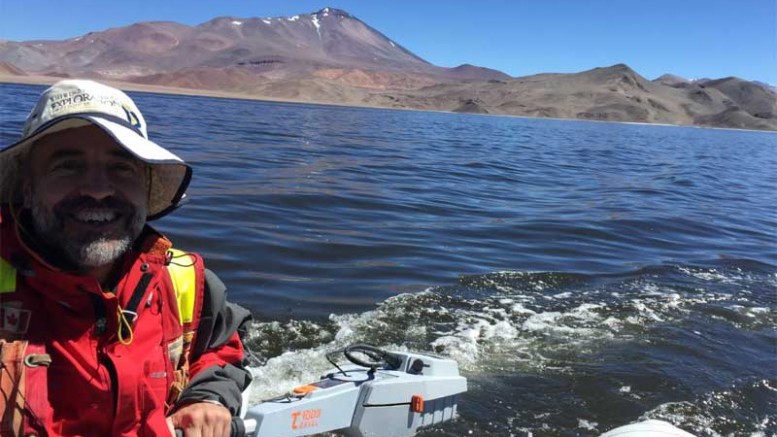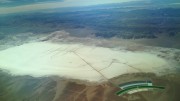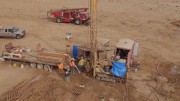From satellite imagery, Tres Quebrados just looked like an ordinary freshwater lake in northwestern Argentina.
But when Waldo Perez stuck his hands into the brownish liquid he discovered something else entirely.
“The first thing you notice is that it isn’t freshwater — it’s brine,” he says in an interview. “It’s oily, it’s dense, it’s heavy, it’s kind of black, and it was totally unexpected. It is a rare phenomenon to find large bodies of lithium brine exposed on surface — the size that you can actually see in a satellite image — so it was missed all these years.”
Initial surface samples came back with some of the highest-grade lithium readings the geologist has ever seen in Argentina, ranging from 1,390 milligrams per litre lithium down to 896 milligrams per litre lithium.
The samples were also incredibly dense, with some measurements as high as 1.30 kg per litre. In contrast, density readings from the region’s other salars range between 1.18 kg per litre and 1.22 kg per litre, Perez says.
“It’s the densest existing brine that I am aware of, and it’s the fourth highest-grade lithium brine known today — at least from the surface samples,” Perez says with excitement. “There are other salty water bodies in the Puna, but none contains this kind of grade of lithium and this density.”

Taking measurements at the Tres Quebrados lithium project. Credit: NEO Lithium
Perez is no stranger to lithium exploration. He led the team that discovered the Cauchari lithium deposit — the third-largest lithium brine deposit in the world — now owned by Lithium Americas (TSX: LAC), a company he set up privately and took public in 2010.
That team left Lithium Americas in 2013 to look for the next big project. They believe they have found it with Tres Quebrados, a discovery they made in December 2015. Perez hopes to list his new company, NEO Lithium, on the TSX Venture Exchange later this year.
“You’ve seen a lot of buzz in the lithium industry recently, but we’re not new to this — we’ve been doing this for more than a decade,” Perez says. “And we have reassembled what is probably one of the most elite teams in the world for this type of deposit.”
Both Cauchari and Tres Quebrados are in northwestern Argentina and make up part of the Puna Plateau, an area also known as the “Lithium Triangle” that straddles Argentina, Chile and Bolivia.
Cauchari is near Argentina’s border with Bolivia, while Tres Quebrados, 500 km south, is closer to the country’s border with Chile.
Tres Quebrados — “3Q” for short — is also 30 km from another large lithium deposit called the “Maricunga” salar in Chile.
Perez points out that the lithium grade at Tres Quebrados is 50% higher than at Cauchari. “As a matter of fact,” he says, “the lowest grade at Tres Quebrados is the highest grade at Cauchari.”
Tres Quebrados also has high potassium and potash values that average 0.8%. “Anywhere else in the world, 0.8% potash is a stand-alone potash project,” Perez says. “Potash in Utah, for example, is produced from brine that is 0.7% or 0.6% potash.”
Perez points out that other lithium brine projects spend part of their budget on adding lime during evaporation to produce potash. But chemical results from preliminary sampling at Tres Quebrados show that the brine does not need lime to precipitate the potash.

NEO Lithium’s Tres Quebrados lithium project. Credit: NEO Lithium
Preliminary brine evaporation simulation indicates that the brine may reach 1% lithium concentration levels and produce potash without using any reagents, which also suggests there is potential to directly ship the concentrate, Perez says.
He estimates that Cauchari and other salars, such as Hombre Muerto (owned by FMC [NYSE: FMC]) and Atacama (owned by Albemarle [NYSE: ALB] and SQM [NYSE: SQM]) all require lime. At Cauchari he estimates that adding lime would make up 30% of the company’s projected operating costs.
“We are already there — we don’t need to do anything — we can produce potash just by letting the brine dry in the sun,” Perez says. “It’s amazing, and potash will be a significant by-product.”
Among the many qualities Tres Quebrados has to offer, he says, is that unlike many lithium brine deposits, it has low concentrations of magnesium and sulphate — impurities that can be difficult and costly to extract.
“They’re not contaminants in terms of being hazardous to the environment, they are contaminants because they sequester your lithium, making it harder to recover,” he says. “You have to look at these two elements to see if you will be able to put a lithium project into production … [an iron] sulphate is a little easier to get rid of, but it will increase your production costs.”
As for magnesium, he says, anything above 10 times more magnesium than lithium would make the project uneconomic. At Tres Quebrados, the average magnesium–lithium concentrations is less than 1.6. As for sulphate, there is no hard limit (as for the number 10 in magnesium), but most projects have sulphate–lithium ratios above 10 or even 50, while Tres Quebrados has a 0.6 sulphate–lithium ratio. That makes the combined magnesium and sulphate impurities among the lowest of all known salars, he says.
While it is still early days and many more studies need to be done, Perez says that the low magnesium and sulphate concentrations at Tres Quebrados could make it one of the lowest-cost lithium projects out there. “The chemistry is clean, which is encouraging,” he says.
Perez adds that so far the chemistry at Tres Quebrados appears to be similar to that of China’s Zhabuye lithium brine deposit in Tibet, which has been in production since 2004. “This type of brine ‘lake’ or reservoir deposit is rare, but it exists, and until now there was just one — Zhabuye. But we have just discovered the second one.”
Other positives include its location — the complex is 250 km from the Chilean port of Caldera and is in a part of Argentina that is uninhabited.
Tres Quebrados consists of three targets — the northern lithium brine reservoir, the central salar and central brine reservoir, and the southern green salar and brine reservoir.
The complex measures 160 sq. km, but the company has staked a 300 sq. km to ensure its hold over the surrounding land package. It also owns 100% of the project and has the rights from surface owners to explore and mine the land.
Perez still marvels at how NEO Lithium staked its claim in an area where most salars have already been taken.
“Argentine geologists and others have been looking for lithium for the last 10 years, so all the salars have been staked by somebody — someone has ownership,” he says. “But this one was missed. It’s amazing, actually, but natural at the same time. If you’re a geologist and you see what looks like a lake, the last thing you want to do is sample it, because you just assume that it’s freshwater, and that it comes from the rivers and the snow. You never think that there will be a whole lake of brine — that’s unprecedented.”
Perez notes that the lake is probably not the target — it’s what he calls the “payback hill,” or the exposed part of the orebody. There is brine in the lake, there is brine under the lake and there is brine in the salar, he explains, the lake is just showing you a part of the orebody.
“It would be like if you were looking for oil and you found a lake of oil. This is what we have here only it’s a lake of brine.”
As for Perez, he made a name for himself long before he started looking for lithium deposits.
He is credited with the discovery and development of the Paso Yobai gold deposit in Paraguay as vice-president and then CEO of Latin American Minerals (TSXV: LAT). He was also project-generation manager for Barrick Gold (TSX: ABX; NYSE: ABX) and Iamgold (TSX: IMG; NYSE: IAG) in Argentina and directly involved in discovering and developing the Lomada de Leiva gold mine, now owned by Patagonia Gold (TSX: PAT; LSE: PGD), and the El Tranquilo gold deposit, also owned by Patagonia Gold.





Be the first to comment on "NEO Lithium hits high-grade"